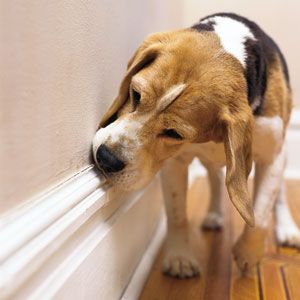
Termites can wreak havoc on your home, chewing into important support beams and destroying doors and windows. Detecting termites early can go a long way in preventing extensive damage, but these insects can be masters of disguise. In this guide, we’ll teach you how to identify a termite problem, treat it, and prevent termites from coming back.
Common Types of Termites
Several species of termites exist in the United States, but three types cause the majority of damage to homes.
Subterranean Termites
Found in all U.S. states except Alaska, these termites nest underground and use mud tubes to reach wood in houses. Their colonies can range from several hundred thousand to a million members, and they’re known for their ability to eat through various materials to access wood.
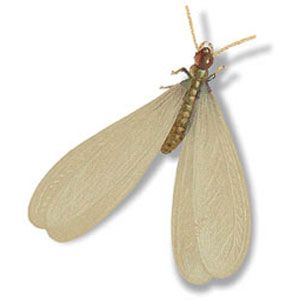
Formosan Termites
Prevalent in the Southeast, Southern California, and Hawaii, this aggressive subterranean species forms large colonies of several million and can cause significant structural damage in a matter of months. They nest underground but also build satellite nests in trees and houses.
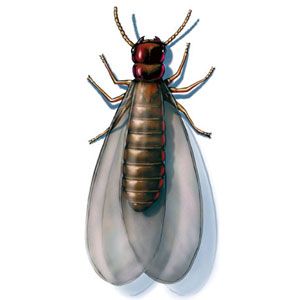
Drywood Termites
Common in the Gulf Coast, Southwest, and Hawaii, these termites form small colonies that can live anywhere in a house without needing contact with the ground.

Preferred Environments for Termites
Termites thrive in specific conditions that provide them with moisture, food, and shelter, such as the following:
- Areas with high humidity and poor ventilation
- Damp wood near foundations, masonry, or leaking gutters
- Mulch and landscaping materials close to the house
- Piles of firewood or lumber stored near the structure
- Wood in direct contact with soil
Identifying Signs of Termite Infestation
Several visual signs can alert you to a potential termite infestation.
Mud Tubes
Look for pencil-thick to inch-wide tunnels on your home’s foundation and crawl-space walls. These tubes shelter subterranean termites as they travel between their nest and food source. If you break open these tubes and see cream-colored insects, it’s a clear sign of an active infestation.

Flying Swarms
Streams of winged termites indoors or piles of shed wings are almost always indicative of an infestation within your house. While seeing them outdoors isn’t necessarily cause for alarm, it’s worth monitoring closely.
Damaged Wood
Inspect wood for blistered or dark areas that break easily when pressed. Termites often leave only a thin veneer of wood intact as they hollow out galleries beneath the surface.
Bulging Floors, Ceilings, or Walls
These could be signs of Formosan termites building satellite nests between joists or studs. Ridges on wallpaper might indicate subterranean termite tunnels.
Holes and Droppings
Pinholes accompanied by piles of sand-grain-sized pellets are typical signs of drywood termites. Larger holes might indicate other wood-boring pests like powder-post beetles or carpenter bees.
Audible and Odor-Producing Clues
While less common, some termite infestations can be detected through sound and smell.
Clicking Sounds
In severe infestations, you might hear a faint clicking sound coming from within walls. This is often the sound of soldier termites banging their heads against wood or shaking their bodies when the colony is disturbed.
Musty Odor
A strong, musty odor similar to mold or mildew can sometimes indicate a termite infestation, especially in enclosed spaces like basements or crawl spaces. Since there can be a number of culprits for musty odors around the home, look for visual signs of termites any time you notice a musty smell without an obvious source.
DIY Termite Detection Strategies
While we recommend professional inspections and treatment, regular DIY inspections can help catch infestations early, potentially saving you thousands of dollars in repair costs.
To effectively monitor your home for termites, follow this inspection checklist.
Exterior Inspection
- Check the foundation for mud tubes or cracks where termites might enter
- Examine wood siding, trim, and decks for signs of damage or hollowness
- Look for piles of discarded wings near doors or windows
Interior Inspection
- Check for bubbling or peeling paint, which may indicate moisture damage
- Look for small holes in drywall or wood surfaces
- Tap wooden beams and listen for hollow sounds
Crawl Space and Basement
- Check wooden supports for signs of damage
- Inspect for moisture issues or standing water
- Look for mud tubes on foundation walls
Attic Inspection
- Check for moisture problems or leaks
- Inspect any exposed wood for signs of termite activity
- Look for damaged or weakened roof trusses
Yard Inspection
- Keep mulch and wood piles away from the house
- Remove dead trees or stumps near the property
- Ensure proper drainage away from the foundation
Advanced Termite Detection Methods
While visual inspections are important, professional pest control experts use a range of advanced techniques and tools to detect termite infestations more accurately. These methods can reveal hidden termite activity and provide a comprehensive assessment of your property’s termite risk.
Professional Inspection
Professional termite inspectors use a combination of visual inspection and specialized techniques to detect termite activity, such as the following:
- Moisture mapping: Since termites are attracted to moisture, professionals use moisture meters to identify areas of high humidity that may be attractive to termites.
- Probing: Experts use tools such as screwdrivers or ice picks to probe wood and identify soft or hollow spots that may indicate termite damage.
- Tapping: By tapping on wood surfaces and listening for hollow sounds, inspectors can identify areas where termites have eaten away the interior.
High-Tech Detection Tools
Modern technology has revolutionized termite detection, providing more accurate and less invasive methods, including these options:
- Acoustic emission detectors: These devices pick up the sound of termites ripping apart wood fibers. They must be placed within a foot or two of where termites are feeding to be effective.
- Borescopes: These flexible instruments with fiber-optic lights allow inspectors to peer through small holes into hollow walls, providing visual confirmation of termite activity.
- Infrared Imaging: This technology detects elevated moisture levels inside intact walls and, when used with a heater, can make termite galleries visible.
- Microwave technology: Working like radar, this tool can detect termite movement through wood and under drywall or tile.
- Trained dogs: Some pest control companies use dogs trained to sniff out the methane termites emit as they digest wood. This is useful for homes with inaccessible crawl spaces or slab foundations.
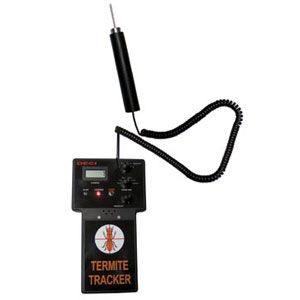
When To Call Professional Pest Control
Certain situations warrant professional intervention, such as these:
- If you find clear signs of termite activity, such as mud tubes or visible damage
- If your home has a history of termite problems
- In areas with high termite pressure, annual professional termite inspections are recommended
- When buying or selling a home, as a professional inspection is often required
Remember, termites can cause significant damage before visible signs appear. If you’re unsure about any findings during your DIY inspection or simply want peace of mind, contact a licensed pest control professional for a thorough evaluation.
Preventive Measures To Deter Termites
Preventing termite infestations is much cheaper than getting rid of an existing termite problem. Implementing strategic landscaping practices and making informed choices about building materials and design can significantly reduce your risk of termite invasions.
Landscaping and Moisture Control
Effective landscaping and moisture management can deter termites if you follow these suggestions:
- Clean overflowing gutters and use splash blocks to divert water away from the foundation
- Don’t bury scrap wood or leave tree stumps close to the house
- Ensure proper grading around the foundation to direct water away from the house
- Fix leaks immediately to prevent moisture accumulation that attracts termites
- Keep wood mulch away from wood siding or trim, maintaining a gap of at least six inches
- Store firewood off the ground and at least 15 feet away from the house
- Trim shrubbery clear of the house to reduce moisture and improve ventilation around the structure
Building Materials and Design Considerations
The building materials and design elements you choose for your home can play a significant role in termite prevention. Here are some tips:
- Consider using borate-treated wood for new construction or renovations, as it provides long-lasting protection against termites
- Design overhangs and other architectural features to minimize water accumulation near the foundation
- Install proper ventilation in crawl spaces and attics to reduce moisture accumulation
- Isolate wood from concrete or masonry with an air space or flashing to prevent direct wood-to-ground contact
- Use stainless steel mesh or other physical barriers during construction to block termite entry points
- Use termite-resistant building materials such as concrete, steel, or treated wood for areas in contact with the ground
Chemical Treatments for Termite Control
When preventive measures aren’t enough, chemical treatments can effectively get rid of termite infestations. These treatments fall into two main categories: soil treatments and barriers, and bait systems. Which type is better depends on the specific situation and type of infestation.
Soil Treatments and Barriers
Soil treatments involve creating a chemical barrier around and under the house to prevent termites from accessing the structure. A pest control specialist pumps a continuous chemical barrier into the soil around and under the house. This can be done during construction or as a treatment for existing homes.
Repellent pesticides keep termites away from treated areas but don’t kill them. Nonrepellent pesticides are more costly but can kill the entire colony as termites unknowingly pass through treated soil.
Pros:
- Can protect your home for at least five years
- Works against subterranean termites
- Works fast
Cons:
- May affect nearby wells and waterways
- May leave a temporary smell
- Uses large quantities of pesticide
Bait Systems
Bait systems are a less invasive alternative to soil treatments. Termite baits are placed in stations buried around the house. Termites take the pesticide-laced bait back to their nest, eventually killing the entire colony.
Pros:
- Can protect inaccessible areas
- Doesn’t require poisons or drilling in the house
- Uses little pesticide, which remains in tamper-resistant containers
Cons:
- May take months to work
- Potentially allows termites to infest a house before finding bait
When choosing between soil treatments and bait systems, consider these factors:
- Cost
- Environmental concerns
- Long-term maintenance requirements
- The structure of your home
- The type of termite infestation
It’s important to note that while DIY versions of these treatments are available, professional application is often more effective and provides more reliable monitoring and follow-up. Always consult a licensed pest control professional to determine the best treatment option for your specific situation.
Non-Chemical Termite Control Methods
For homeowners looking to avoid chemical treatments, there are several nontoxic methods to control termite infestations. These approaches focus on creating inhospitable environments for termites or directly eliminating them without using pesticides.
Heat Treatment Options
Heat treatment is a popular non-chemical method for eradicating termites. It’s particularly effective against drywood termites. Your entire house is wrapped in a tent, similar to fumigation. Hot air is then pumped in until the center of the framing lumber reaches 120 degrees Fahrenheit for at least half an hour. This temperature is lethal to termites but safe for the house structure.
Pros:
- Is effective against both drywood termites and many wood-boring beetles
- Is typically completed in one day
- Leaves no toxic residues, allowing you to immediately go back into your home
Cons:
- Doesn’t provide long-term protection against reinfestation
- May not be suitable for all home types or in all weather conditions
- Requires removing or protecting heat-sensitive items such as electronics and vinyl windows
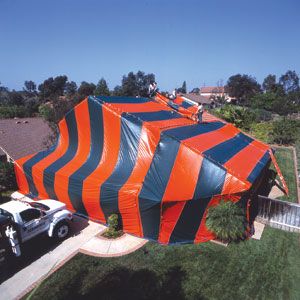
Biological Control Strategies
Biological control methods use natural predators or pathogens to manage termite populations. For example, nematodes are microscopic worms that naturally prey on termites. They can be applied to soil around the home to reduce termite populations. Certain fungi, such as Metarhizium anisopliae, are pathogenic to termites and used to control infestations.
Pros:
- Can provide long-term control when properly applied
- Is environmentally friendly
- Poses no risk to humans or pets
Cons:
- Isn’t always effective depending on environmental conditions
- May require repeated applications
- May take longer to show results compared to chemical treatments
While biological control methods are still evolving, they show promise as part of an integrated pest management approach. Other non-chemical methods include electrocution and microwave technology. For electrocution, a professional sends high-voltage discharges through the wood to eliminate the termites. This is effective for spot treatments but may not reach all infested areas. Microwaves can be used to heat and kill termites within wood structures. This method is noninvasive but limited to accessible areas.
While these non-chemical approaches can be effective, they often work best as part of a comprehensive termite management strategy that may include preventive measures and ongoing monitoring. Consult a qualified pest control professional to determine the most appropriate treatment plan for your specific situation.
What To Consider When Hiring a Pest Control Company
Keep the following in mind when looking for a professional pest control company:
- Licensing and certification: Check that the company is licensed in your state and that technicians have termite control certifications.
- Experience and reputation: Look for companies with a proven track record in termite control. Check online reviews and ask for references.
- Inspection process: A good termite company will do a thorough inspection of your home before making any treatment recommendations. Ask about the tools and techniques used during inspections.
- Treatment options: Choose a provider that offers a range of treatment methods tailored to your specific situation.
- Warranty and follow-up services: Ask about warranties on treatments and follow-up services for ongoing protection. A reputable company should stand by its work and provide regular inspections to monitor for new termite activity.
- Customer service: Look for a company that’s willing to answer your questions, provide detailed explanations, and offer support throughout the process.
